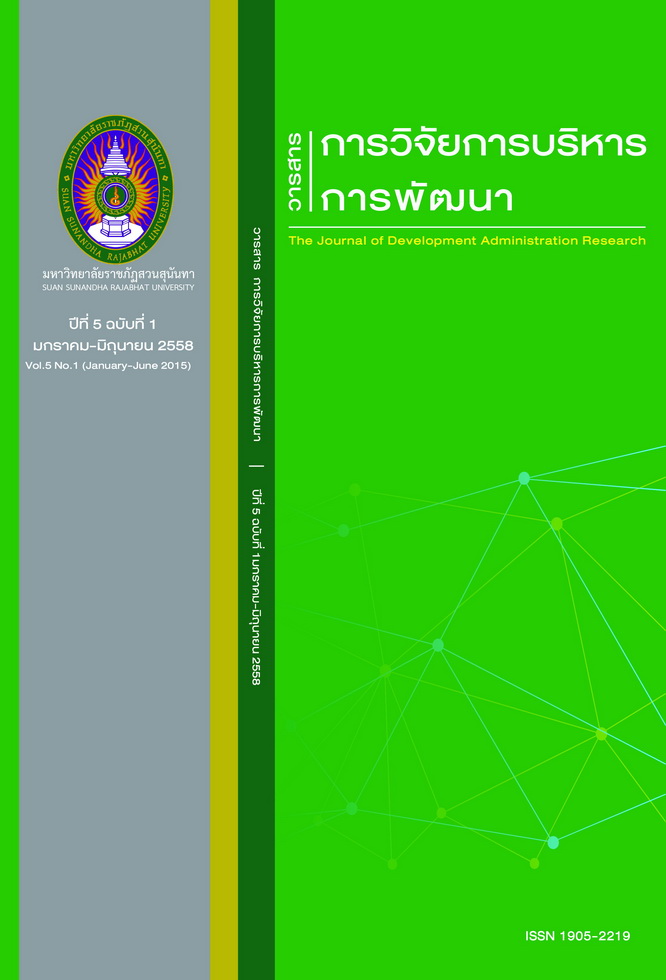ปัจจัยที่ส่งผลต่อศักยภาพการแข่งขันของของผู้ผลิตชิ้นส่วนรถยนต์ในการผลิตแบบลีน
คำสำคัญ:
ศักยภาพการแข่งขัน, ผู้ผลิตชิ้นส่วนรถยนต์, การผลิตแบบลีนบทคัดย่อ
การวิจัยนี้มีวัตถุประสงค์เพื่อศึกษาปัจจัยที่ส่งผลต่อศักยภาพการแข่งขันของของผู้ผลิตชิ้นส่วนรถยนต์ในการผลิตแบบลีน ใช้วิธีการวิจัยเชิงปริมาณ กลุ่มตัวอย่างที่ใช้ในการวิจัยคือ ผู้ผลิตชิ้นส่วนรถยนต์ที่อยู่ในกรุงเทพมหานคร ภาคกลาง และภาคตะวันออก จำนวน 288 บริษัท วิเคราะห์ข้อมูลโดยใช้เทคนิคการวิเคราะห์แบบจำลองสมการโครงสร้าง ด้วยโปรแกรม PLS-Graph ผลการวิจัย
พบว่า การบำรุงรักษาผลผลิตรวมและการควบคุมคุณภาพโดยรวม มีผลโดยตรงต่อการผลิตแบบลีน ขณะที่คุณลักษณะเอื้ออำนวย เช่น ทำเลที่ตั้งและเทคโนโลยีมีส่วนเช่นกัน การผลิตแบบลีนมีผลต่อผลิตภาพ ได้แก่ การส่งมอบ คุณภาพผลิตภัณฑ์และต้นทุน ส่งผลให้เกิดศักยภาพการแข่งขันในส่วนแบ่งการตลาด
ดังนั้นจึงควรมีการอบรมวิธีการผลิตแบบลีนและช่วยการพัฒนาในผู้ผลิตชิ้นส่วนรถยนต์อย่างกว้างขวาและต่อเนื่อง รวมทั้งอำนวยความสะดวกในการจัดหาอุปกรณ์ที่ใช้ในการผลิตแบบลีนด้วย เพื่อให้อุตสาหกรรมผลิตชิ้นส่วนรถยนต์ซึ่งมีทรัพยากรบุคคลเกี่ยวข้องเป็นจำนวนมากได้มีการพัฒนาและยกระดับให้สูงขึ้น
เอกสารอ้างอิง
บัณฑิต ผังนิรันดร์ และวนิดา สุวรรณนิพนธ์. (2547). การวิจัยทางธุรกิจ. กรุงเทพฯ: มหาวิทยาลัย ราชภัฏสวนสุนันทา.
Ahuja, I. P. S., & Khamba, J. S. (2008). Justification of total productive maintenance initiatives in Indian manufacturing industry for achieving core competitiveness. Journal of Manufacturing Technology Management, 19(5): 645-669.
Alastair, S. (1999). A guide to performance measurement and non-financial indicators. Retrieved April 1, 2007, from http://www.fpm.com/journal/
Chin, W. W. (2001). PLS-Graph User’s guide versions 3.0. Houston, TX: University of Houston, C.T, Bauer College of Business.
Eng, Q. E., & Yusof, S. M. (2003). A survey of TQM practices in the Malaysian electrical and electronic industry. Retrieved October 10, 2008, from https://www.fkm.ufm
Farooquie, J. A., & Mohapatra, A. B. (2007). Japanese techniques and Indian manufacturing: Some inferences. Retrieved November 13, 2008, from http://ieexploieee. org
Field, A. (2003). Designing a Questionnaire. Retrieved May 28, 2010, from www.Statisticshell.com
Garg, I. (2008). Employee training and participation – A must for total quality management. Retrieve November 25, 2008, from www.cluteinstitute-onlinejournals.com
Guiffrida, A. L., & Nagi, R. (1996). Fuzzy set theory applications in production management research: A literature surve. Retrieved September 9, 2007, from www.eng.buffalo.edu
Hashmi, K. (2008). Introduction and implementation of total quality management (TQM). Retrieved July 6, 2008, from http://wwwisixsigma.com/library.com
Ichimura, M., & Arunachalam, S. (2003). Development of a training framework for lean manufacturing-an empirical study. Retrieved April 27, 2008, from m.ichimura@uel.ac.uk
Karnani, A. (2007). Equilibrium market share-a measure of competitive strength. Strategic Management Journal, 3(1): 43-51.
Katayama, H., & Bennett, D. (1996). Lean production in a changing competitive world. International Journal of Operations & Production Management, 16(2), 823.
Kotelnikov, V. (2001). Performance measurement. Retrieved November 12, 2006, from www.1000ventures.com
Kotelnikov, V. (2006). Lean production doing more with less. Retrieved November 26, 2006, from www.1000ventures.com
Marosszeky, M., & Karim, K. (1997). Performance measurement. Retrieved November 2, 2006, from www.iglc.net
Miller, J. (1998, August 6). Targeting customers, building stronger relationships and Increasing sales. Auto Inc. Retrieved May 18, 2008, from http://www.asashop.org/ autoinc/june98.manage.htm
Moreira, M. R., & Alves, R. (2006). How far from just-in-time are Portugese firms ? A survey of its progress and perception. Retrieved October 4, 2008, from www.fep.up.pt
Picther, M. (2003). Examining just-in-time and theory of constraints: Lean direction. Retrieved August 3, 2007, from http://www.sme.org/cgi-bin/get-newsletter.pl
Prasad, R. N. (2004). Fiji export competitiveness: A comparison with selected small island developing states. Retrieved May 10, 2008, from www.reserveBank.gov.fj/docs/2004~06%20WP.pdf
Pyzdek, T. (2000). Six sigma and lean production. Retrieved November 5, 2006, from http://www.mmo.org.tr/endustrim
Rebecca, W. L. (2003). Just-intime manufacturing and organizational performance: The role of information technology. Retrieved April 10, 2008, from http://www.allbusiness.com/technology/752300-1.htm
Roberts, J. (1997). Total productive maintenance. Retrieved September 30, 2006, from http://engr.nms.edu/-etti/fall97/manufacturing/gon2.htm
Seagraves, T. L. (2004). The competitive weapon: Using ROI measurement to drive results. Retrieved July 29, 2007, from http://www.astd.org/NR/rdonlyres
Spear, S. J. (2002). Just-in-time in practice at Toyota. Retrieved November 4, 2006, from sspear@hbs.edu
Stewart, P. (2000). Leantimes for labour: Trade unions, management and employees in process of change. Retrieved December 5, 2008, from Stewart PR@Charlotte Yates.
Thun, E. (2007). International business and global governance. Retrieved March 16, 2008, from http://eanh.net/notes/IBGcomp.pdf
Venkatesh, J. (2005). An introduction to total productive maintenance. Retrieved November 12, 2006, from http://www.plant-maintenance.com
Williamson, R. M. (2006). Total productive maintenance: What it is and what it is not. Retrieved November 11, 2006, from www.swspitcraw.com
Yaffee, R. A. (2003). Common Correlation and Reliability Analysis with SPSS for Windows. Retrieved May 25, 2010, from http://www.nyu.edu/its/statistics/ Docs/correlate.htm
Youngman, K. J. (2003). A guide to implementing the theory of constraints (TOC). Retrieved August 11, 2007, from http://www.dbrmfg.co.nz/production.htm
ดาวน์โหลด
เผยแพร่แล้ว
รูปแบบการอ้างอิง
ฉบับ
ประเภทบทความ
สัญญาอนุญาต
บทความที่ได้รับการตีพิมพ์เป็นลิขสิทธิ์ของมหาวิทยาลัยราชภัฏสวนสุนันทา
ข้อความที่ปรากฏในบทความแต่ละเรื่องในวารสารวิชาการเล่มนี้เป็นความคิดเห็นส่วนตัวของผู้เขียนแต่ละท่านไม่เกี่ยวข้องกับมหาวิทยาลัยราชภัฏสวนสุนันทา และคณาจารย์ท่านอื่นๆ ในมหาวิทยาลัยฯ แต่อย่างใด ความรับผิดชอบองค์ประกอบทั้งหมดของบทความแต่ละเรื่องเป็นของผู้เขียนแต่ละท่าน หากมีความผิดพลาดใดๆ ผู้เขียนแต่ละท่านจะรับผิดชอบบทความของตนเองแต่ผู้เดียว




